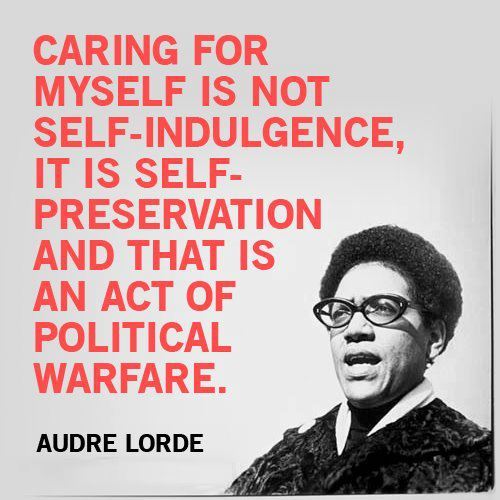3 self-care techniques
03 Sep 2016in today’s world, it’s easier than ever to be connected. digital tools help us see the world from the perspective of others, ubiquitous computing puts much of human knowledge in our palms, and the democratization of means of production make content production continuous and everywhere.
in such a reality, it’s easier than ever to be overwhelmed, especially if you care about social justice. there is always a battle to win, a cause to support, or a new voice to hear.
in all this, self-care is still just as important as it has always been… it might even be more important now. this audre lorde quote has continued to come up in conversation because of all these trends:
“Caring for myself is not self-indulgence, it is self-preservation, and that is an act of political warfare.”
— audre lorde

the following three techniques i’ve either used for myself or offered to others.
- if your calendar is an important part of your personal system, use it to block off self-care time. this is what i do and i just take whole evenings and block them off. i put an actual event, usually from 6-10p, and then just refuse to schedule anything during that time. i also have a few other 2-3 hour blocks that i float around my calendar. because i use my calendar so rigorously, i know that seeing a big block of unavailable time means i make decisions about my day knowing that i have less time to meet with other people or whatever. super helpful for me, doesn’t always work with other people.
- if time-tracking is a part of your personal system, but calendaring isn’t that helpful, setting a time goal for self-care time and keeping track of your progress also can be great. if you know that you need 6-7 hours of unwind time per week, as long as you can make sure you get that, great. you can divide the time up however you want (1h/day every day, all the time on one day, could be different from week to week, whatever) as long as you get it all.
- make a list of self-care activities and try to do a certain number of them each week. if time-tracking isn’t a significant part of your system at all, a checklist of activities with a goal number can work well. for example, your list of activities might be: watching an episode of a show, going for a run, swimming, and reading. and you might know that if you get seven “points,” you feel good. week 1 might look like 3 episodes, 1 run, 1 swim, and 2 reading blocks. week 2 might have bad weather so you just read 4x and watch 3 episodes.
there are obviously more ways to make sure you’re getting enough self-care time, but these three techniques have been helpful to me and seem helpful to others.